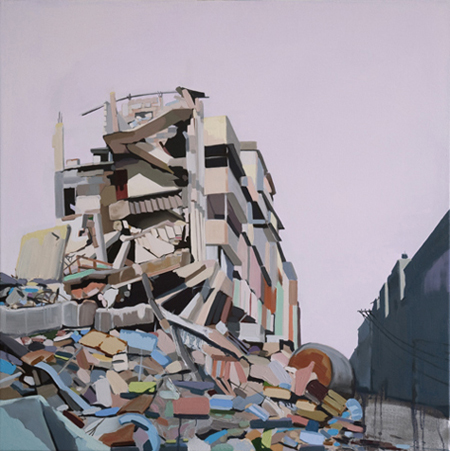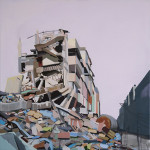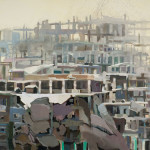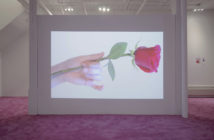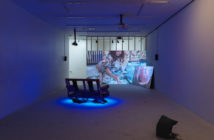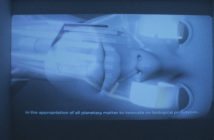In his Brooklyn Rail essay last spring How to Look at Postmodern Painting and Its Criticism, Irving Sandler described his witness to the death of modernism, and emergence of postmodernism. Sandler writes that art criticism has failed to evolve after its 1970s heyday, and that no longer are there the "riveting polemics…Art world discourse has become unfocused and undramatic, and in the minds of many, irrelevant."
As someone new to the art world, someone younger than Jesus, I agree that it seems now that what art criticism needs is an "electrodynamic model" which focuses on more than the artist as individual. That said I'd like to add a few notes on painting in our post-modern era, especially in the wake of the New Museum's Generational.
Perhaps due to its focus on new media art, Younger Than Jesus, was almost completely devoid in painting of quality. By quality, I mean that which stand the test of time because of their enduring reverberation in one's mind—if they are made from ephemeral materials or not. Good painting should find resonance with a mass audience through its aesthetic rendition of that which is culturally poignant. In this mass media age, with the proliferation of the Internet, blogs and in general the accumulation of spaces never imaged before 1994, it does not seem odd that my generation of artists has yet to produce a painter truly worthy of recognition in Younger Than Jesus. The exhibition's most effective works were installations such as Chu Yun's This is XX, (2006), which implies that indeed relational aesthetics are more imperatively evocative in contemporary art than painting. In all fairness, the New Museum does boast some note worthy painters—for instance, Tala Madani's comically chilling small-scale oils—but they shrink in comparison to videos and installations blaring from down the gallery.
Sandler is right. We are very far cry from a time in which Malevich proclaimed that with his black square, he would "tear to pieces and devour the remains of your art." But I believe that painting—good painting—is more urgent than ever. Painting, with its formalism, is capable of making sensual the odious conflicts that currently plague the world at large. Yes, postmodern painters must, in Sandler's estimation, "re-make the new," in order to enliven the rigor mortis of painting's gesture. Despite what one though while perusing the New Museum's galleries this summer, there are painters who are now making work that speaks to the anonymous masses, whose work is found poignant as it references not the internal but the external sphere, those accrued spheres delivered by the Internet and its spawn.
-
For example, consider 2525's work. Charuvi, who graduated from the School of Visual Arts this spring, articulates a subtly expedient message within her skillful "remakes" of Modern masters, such as Cezanne or de Kooning. Before moving to the States and enrolling in SVA, Charuvi was painting the Israeli land and city scape in a photo-realist style. It was not until Charuvi started painting Palestinian buildings rubbled by the eternal struggle between her country and its neighbor that she found her stylistic niche in painterly abstraction. Derivative of de Kooning with her bravura brushstroke figuring demolished roofs, cars and homes, Charuvi references the conflicts of our external world instead of just her internal psyche for subject matter. Painterly abstraction is the only way to depict these rubbles, as they have been literally reduced to pure matter—meaning they used to be actual structures but now mean something else entirely. Whereas before these structures along the Gaza Strip signified building, in their ruined state they denote the conflicted political relationship between Israel and Palestine. Charuvi says that she "observe[s]them in geometric chunks of color" instead of rubbles or ruins. These "chunks of color," much like the passage of Cezanne, make Charuvi's paintings beautiful: the viewer is seduced by the formal qualities of the works before they understand the political implications of what is depicted. In doing so, Charuvi subscribes to critic Dave Hickey's idea of beauty—that which seduces us into seeing something we'd rather not. Anyone—be they Israeli, Palestinian, American or otherwise, does not want to realize that these ruins are the manifestation of the decades of unresolved religious and political tensions that have transcended generations of people.
In her paintings, Charuvi removes people and replaces them with brushstrokes or planes of rich color. In her work, nationality is abstract. As an Israeli, Charuvi was taught to see Palestine as a part of a larger, indefinable anti-Semitic world. Identity is therefore constructed in accordance to spirituality and how it contrasts to others. Indicative of our increasingly post-nation age, the confusion and obscuring of national lines is evident in Charuvi's abstraction and use of color. Just as the differences between Israeli and Palestinian are ethereal, the forms in Charuvi's work escape definition.
Charuvi gathers her source material from the Internet; as an Israeli citizen, she cannot enter Palestinian areas. While the news image is banal in its document of carnage, Charuvi translates their content into the sensual, the beautiful and the seductive through painterly abstraction. Charuvi's paintings are an exquisitely quiet call to reassess the incessant quarrels of the past, and "remaking" modern painting is the only way in which she could pronounce such a message. Depicting the mutilated building with Charuvi's expressive gesture transforms the horrific into the persuasively sensuous. The gesture is universalizing, and softly imbued by Charuvi's personal relationship with those who destroy. Her paintings subvert the ruins' political connotations; instead, with her abstractions, Charuvi seems to ask why these timeless clashes must haunt us still. A solemn entreaty, Charuvi's works beg a questioning of the ceaseless strife between Israel and Palestine.
-
I'll return to Hickey now in answer to Sandler. Perhaps Sandler is right—there are no more "riveting polemics" of the 1970s. But why not? Painting must evolve to be culturally and politically resonant if it is to survive—it must embrace Hickey's idea of "gorgeous politics" in order to compete with new media. The meaning of these "politics" can shift in connotation from artist to artist. The critic must find and brave the nuanced waves of these artists, such as Charuvi, who, according to Hickey in his essayProm Night in the Flatland, delve into a "richer reality, a better language, a more complex sense of community, and more courageous art." Just as we have neglected in our major shows, such as Younger Than Jesus, the painters who very much are dealing with our opulent actuality, hasn't our criticism grown weary of wading through the postmodernism's pluralism? Yes, art criticism must meld with art in order to create a valuable discourse regarding ‘quality' art.
But I believe that art critics must look past the mere "remakes" to those painters who, like Charuvi, coast in uncharted political and emotive terrain—art critics must absorb quickly these recycling of Modernism's achievements in order to reach the real meat of a ‘quality' postmodern painting. Here is where I split with Hickey: I believe (any maybe naively so) that art critics must tease out the artists' intones of significance in order to better learn the anonymous masses. Charuvi, with her hushed yet sumptuous intonations of violence, is one such an example of an painter who's urgent message critics must search out and articulate among the jargon-filled topographies of postmodern art making.
- Noa Charuvi, Purple Sky, 2009, Oil on canvas, 36 x 36 inches
- Noa Charuvi, Babel , 2009, Oil on canvas, 72 x 96 inches
- Chun Yun, Emma (This is XX), 2006, Mixed media (Photo: Hu Fang)
All images are courtesy of the artists' websites.

